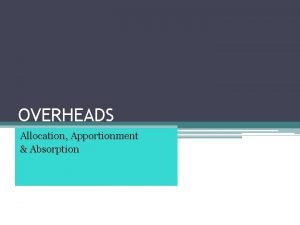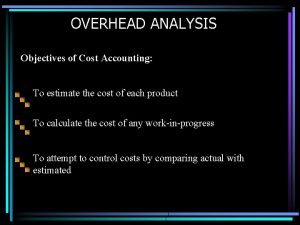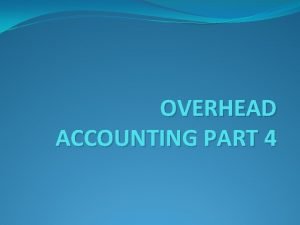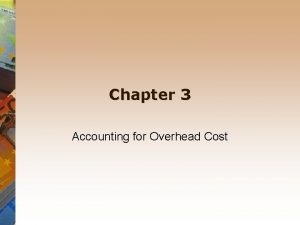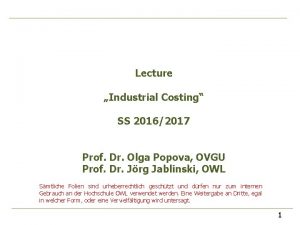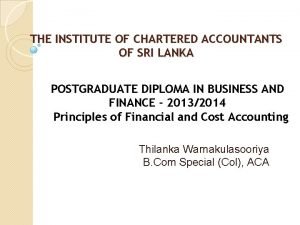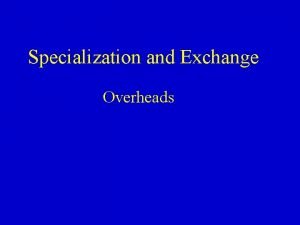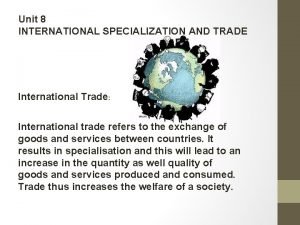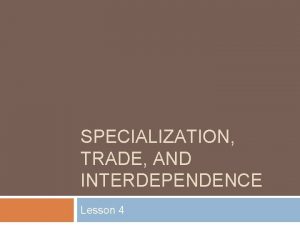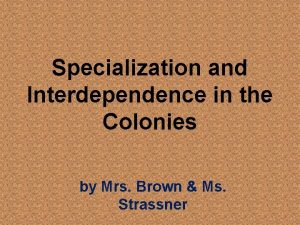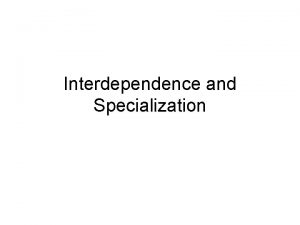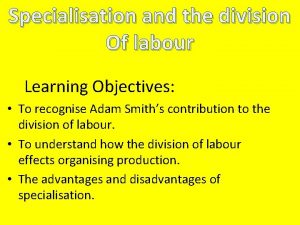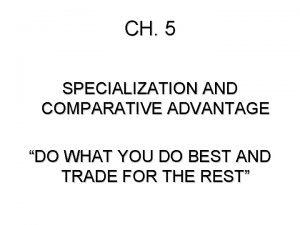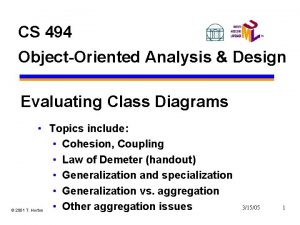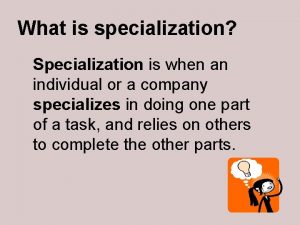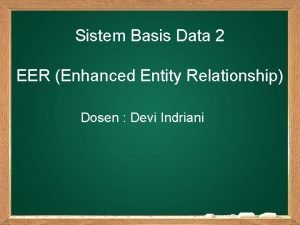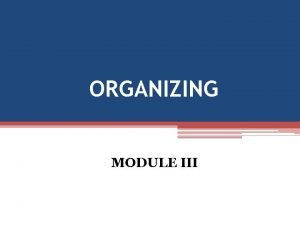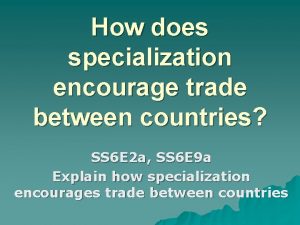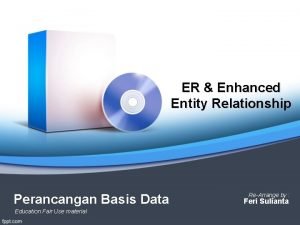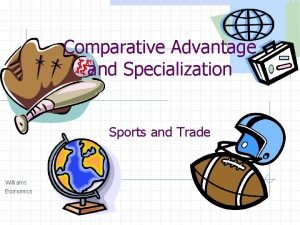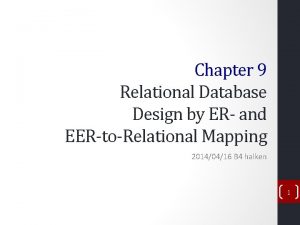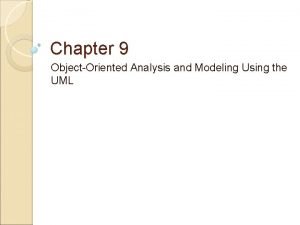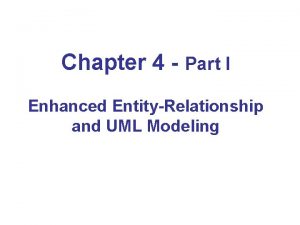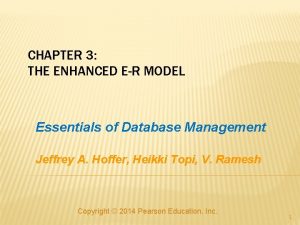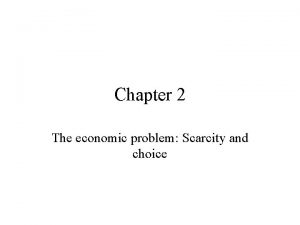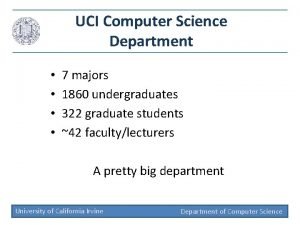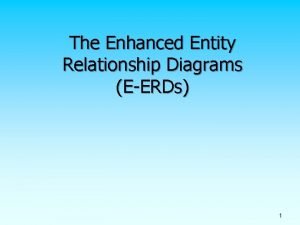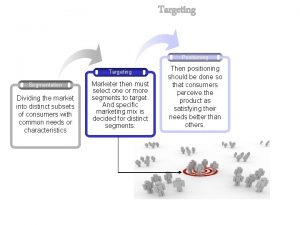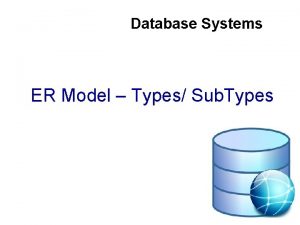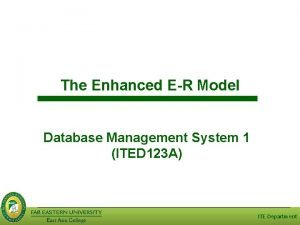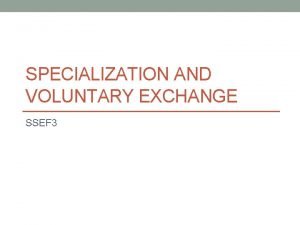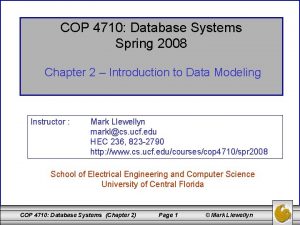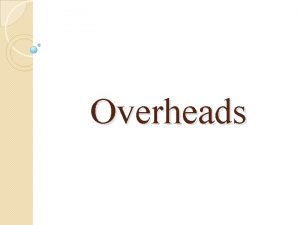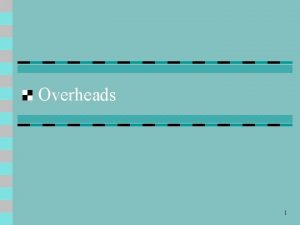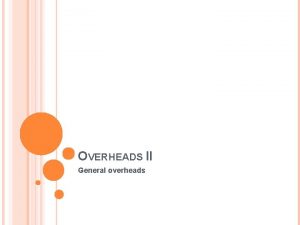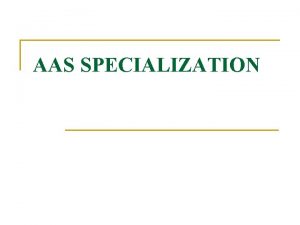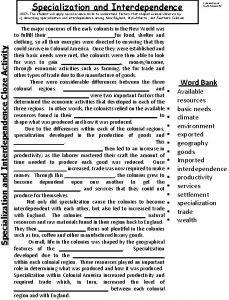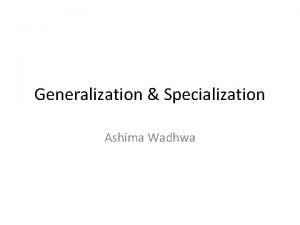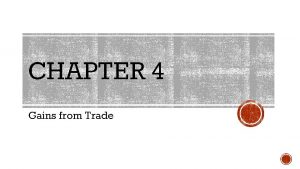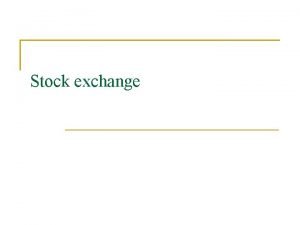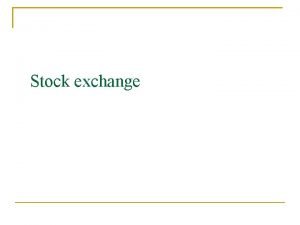Specialization and Exchange Overheads Specialization and exchange Specialization

















































- Slides: 49

Specialization and Exchange Overheads

Specialization and exchange Specialization - A method of production in which each agent (firm) concentrates on a limited number of activities Exchange - The act of trading with others to obtain what we desire

Specialization and Exchange There are gains to specializing in a small number of tasks and trading the products we produce as compared to doing it all ourselves

Examples Steak and eggs Beef and laying hens Medical care and automobile care Hair styling and plumbing

Principle of specialization and exchange Specialization and exchange enable us to enjoy greater production and higher living standards than would otherwise be possible WHY? As a result, all economies have been characterized by high degrees of specialization and exchange

Why specialization and exchange make us better off 3 reasons specialization pays 1. Time to learn & acquire skills / learning by doing Finish carpenter X- ray technician Electrical engineer MIS consultant

2. Set-up and switching time Triplets in the copy shop Fire brigade Ice cream sundaes Wooden pallet construction

Adam Smith and Pins

3. Comparative advantage

Why specialization and exchange make us better off 1. Time to learn & acquire skills / learning by doing 2. Set-up and switching time 3. Comparative advantage

What is comparative advantage? Comparative advantage is the ability to produce a good or service at a lower opportunity cost than other producers

The track coach’s dilemma Two runners (A & W) are projected to place 1 -2 in 400 meter hurdles, and 2 -5 in the 400 meter dash Scoring is as follows: Place Points 1 7 2 5 3 4 4 3 5 2 6 1 Only one of the runners can run each race What should he do?

Figure it out A will be 1 st in hurdles, 2 nd in dash W will be 2 nd in hurdles, 5 th in dash Hurdles Place Points A W 1 7 4 3 10 W A 1 7 2 5 12 Place 1 2 3 4 5 Dash Place Points Total Points 7 5 4 3 2

Absolute versus comparative advantage An individual producer has an absolute advantage in the production of a product if he has the ability to produce the good or service using fewer resources than other producers use. An individual producer has a comparative advantage in the production of a product if she has the ability to produce the good or service at a lower opportunity cost than other producers.

The Flintstone Economy Output per hour Turnips Mastodons Fred 20 1 Wilma 80 2

This data is output per unit of input data Turnips or mastodons per hour Cars per day Tons per acre Shirts per hour Returns per dollar invested

Who has the advantage in what? Wilma has an absolute advantage in turnip gathering and in mastodon hunting Wilma is more efficient at both activities!!

Comparative Advantage is Measured in Terms of Opportunity Cost The opportunity cost of any choice is what we give up when we make that choice

What does Fred give up to get a mastodon? Turnips Fred 20 Mastodons 1 Output per hour Wilma 80 2 Fred gives up 20 turnips to get one mastodon 1 mastodon costs 20 turnips

Opportunity Cost of: 1 Turnip Fred Wilma 1 Mastodon 20 turnips

Pricing in the Flintstone economy with turnips as the unit of exchange Individual Opportunity Cost Fred 1 mastodon costs 20 turnips 20 / 1 = 20 If Fred could pick up 40 ants per hour then Fred 1 ant costs 1/2 turnip 20 /40 = 1/2

What about Wilma? Turnips Fred 20 Mastodons 1 Output per hour Wilma 80 2 Wilma gives up 40 turnips per mastodon 80 / 2 = 40 1 mastodon costs 40 turnips

Opportunity Cost of: 1 Turnip Fred Wilma 1 Mastodon 20 turnips 40 turnips

Who has the lowest opportunity cost for mastodons? Turnips Mastodons Fred 20 t Wilma 40 t Fred has a comparative advantage in mastodon hunting!

Pricing in the Flintstone economy with turnips as the unit of exchange Individual Opportunity Cost Fred 1 mastodon costs 20 turnips Wilma 1 mastodon costs 40 turnips Fred gives up less turnips for a mastodon Fred has a comparative advantage in mastodon hunting!

The good that is the unit of comparison (or exchange) (or account) in an economy is called the numeraire good The numeraire good is used as a way of measuring the opportunity cost of other goods, or how many units of the numeriare must be given up for one unit of a given good

In our example so far, turnips were the unit of exchange or numeraire Turnips Fred Wilma Mastodons 20 t 40 t Now make mastodons the unit of exchange

What does Fred give up to get a turnip? Turnips Fred 20 Mastodons 1 Output per hour Wilma 80 2 Fred gives up 1/20 of a mastodon per turnip 1 turnip costs 1/20 of a mastodon

Opportunity Cost of: 1 Turnip Fred Wilma 1/20 mastodon 1 Mastodon 20 turnips 40 turnips

What about Wilma? Turnips Mastodons Fred 20 1 Wilma 80 2 Wilma gives up 1/40 mastodon per turnip 2 / 80 = 1/40 1 turnip costs 1/40 of a mastodon

Opportunity Cost of: 1 Turnip Fred Wilma 1 Mastodon 1/20 mastodon 20 turnips 1/40 mastodon 40 turnips

Who has the lowest opportunity cost for turnips? Turnips Mastodons Fred 1/20 m 20 t Wilma 1/40 m 40 t Wilma has a comparative advantage in turnip digging!

Pricing in the Flintstone economy with mastodons as the unit of exchange (numeraire) Individual Opportunity Cost Fred 1 turnip costs 1/20 of a mastodon Wilma 1 turnip costs 1/40 of a mastodon Wilma gives up less mastodons for a turnip Wilma has a comparative advantage in turnip digging!

How to determine who has the comparative advantage in what 1. Determine the output period of each agent 2. Make an opportunity cost table (agents by goods) 3. For each good (column) choose a unit of exchange 4. Determine the opportunity cost of each good in terms of the unit of exchange by dividing the production of the unit of exchange by the production of the other good 5. The person with the lower opportunity cost has a comparative advantage in the production of each good

Example Computation Fish Cassava Crusoe 5 20 Crusoe 4 c 1/4 f Friday 8 24 Friday 3 c 1/3 f 3. Cassava is unit of exchange for fish Fish is unit of exchange for cassava 4. Fill in comparative advantage table (unit of exchange per unit of good) 5. Friday has the comparative advantage in fish production 5 a. Crusoe has the comparative advantage in cassava production

What is comparative advantage? Comparative advantage is the ability to produce a good or service at a lower opportunity cost than other producers

Utilizing comparative advantage leads to more total output

Output before specialization Hours Digging Fred 6 Wilma 6 Total 12 Turnips Hours Hunting Mastodons 120 2 2 480 2 4 600 4 6 Output after specialization Hours Digging Turnips Hours Hunting Mastodons Fred 0 0 8 8 Wilma 8 640 0 0 Total 8 640 8 8

Total production of every good and service will be greatest when individuals specialize according to their comparative advantage.

The three problems of resource allocation 1. Which goods and services should be produced with society’s resources? 2. How should the goods and services be produced? 3. Who should get these goods and services?

Resource allocation is. . . the method used to determine which goods and services will be produced, how they will be produced, and who will get them

Three methods of resource allocation Tradition Command Market

What is a price? The price of a product is the amount of money that must be paid to a seller to obtain a good or service.

Prices are a signal for resource allocation

How prices lead to changes in resource allocation An increase is the desire for product will cause consumers to bid up the price of the product. A higher price for a product will encourage sellers to produce (obtain) and then sell more of the product. To produce more of the product, sellers will buy more of the resources needed to produce it. The owners of these resources will have a higher income. The owners of these resources will now have more influence on what is produced.

Example Gas-powered model airplanes Patent on nerve gas antidote Terrorists start setting off nerve gas Income of patent owner He likes to fly model airplanes Production of airplanes

Three systems of resource ownership Communism - resources owned in common Socialism - resources owned by the state Capitalism - resources owned privately

Types of Economic Systems Resource Allocation Private Market Command Market Capitalism Centrally Planned Capitalism Market Socialism Centrally Planned Socialism Resource Ownership State

The End
 Allocation apportionment and absorption of overheads
Allocation apportionment and absorption of overheads Objectives of cost analysis
Objectives of cost analysis Computation of machine hour rate
Computation of machine hour rate How to calculate absorption cost per unit
How to calculate absorption cost per unit Primary distribution of overheads
Primary distribution of overheads Classification of overheads
Classification of overheads Specialization and exchange
Specialization and exchange Real exchange rate formula
Real exchange rate formula Voluntary exchange
Voluntary exchange Gas exchange key events in gas exchange
Gas exchange key events in gas exchange Specialization in international trade
Specialization in international trade Comparative advantage exists when one person can produce
Comparative advantage exists when one person can produce Specialization and interdependence
Specialization and interdependence Specialization and interdependence
Specialization and interdependence Specialization and interdependence
Specialization and interdependence Division of labour disadvantages
Division of labour disadvantages Specialization and comparative advantage
Specialization and comparative advantage Economies and diseconomies of work specialization
Economies and diseconomies of work specialization Generalization and specialization in java
Generalization and specialization in java Specialization is when
Specialization is when Contoh kasus eer
Contoh kasus eer Work specialization
Work specialization How does specialization encourage trade between countries?
How does specialization encourage trade between countries? Partial specialization rule adalah
Partial specialization rule adalah Specialization economics
Specialization economics Supervisor supervisee
Supervisor supervisee Uml specialization
Uml specialization Uml specialization
Uml specialization Total specialization rule example
Total specialization rule example Packaged data models
Packaged data models Specialization economics
Specialization economics Business information management uci
Business information management uci Supertype subtype relationship er diagram
Supertype subtype relationship er diagram Our specialization
Our specialization Single segment concentration
Single segment concentration Hybrid sales organization structure
Hybrid sales organization structure Infusion specialization
Infusion specialization Partial specialization rule example
Partial specialization rule example Specialization vs differentiation
Specialization vs differentiation Advantages of specialization
Advantages of specialization What are the seven characteristics of civilization
What are the seven characteristics of civilization Database specialization
Database specialization Examples of voluntary exchange
Examples of voluntary exchange Ibm ot
Ibm ot Specialization
Specialization Database specialization
Database specialization Database specialization
Database specialization Packaged data models:
Packaged data models: Example of cell specialization
Example of cell specialization Cell specialization definition
Cell specialization definition
